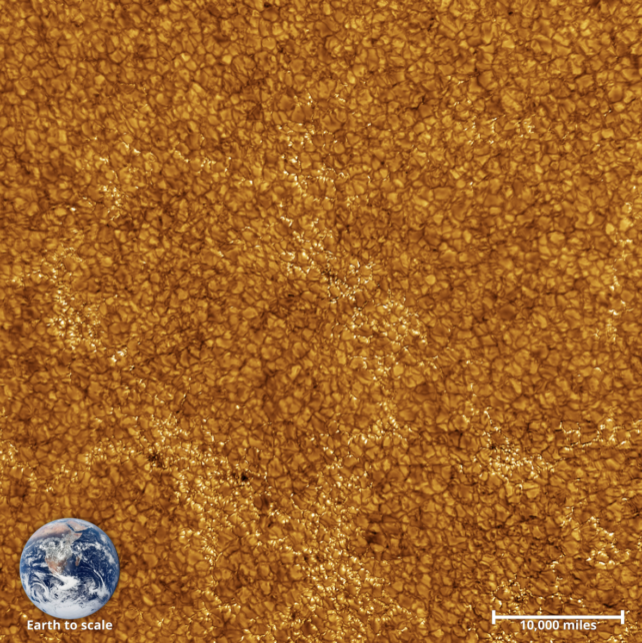The face of our Sun has been beautifully captured in a stunning photograph taken by the most potent solar telescope in the world, as reported first by ScienceAlert.
The middle layer of the Sun's atmosphere, referred to as the chromosphere, seems almost like a shag rug when viewed up close at a resolution of only 18 kilometers.

The image above shows scorching plasma streaming into the corona from what is more clearly seen in the image below as a structure of pores resembling a honeycomb. Each of these granules, or blistering blobs, measures around 1,600 kilometers (994 miles) in width.
It is worth noting that these images are only a small fraction of the Sun's entire diameter at 82,500 kilometers (51,260 miles) broad. This means that astronomers have scaled up our planet to put into perspective the enormous size of these photographs.

The astounding accomplishment, which comes to fruition after 25 years of painstaking planning, commemorates the first anniversary of the Inouye Solar Telescope, which is the most potent instrument of its type.
Only during a total solar eclipse can one see the Sun's chromosphere, located below the corona, and obscures the star by forming a crimson rim around it. However, the advancement in technology has made it possible for astronomers to observe the face of the Sun.
ScienceAlert noted that humans have never before looked so closely at our solar system's light source. The Manhattan island-sized characteristics of the Sun's chromosphere can be seen via the Inouye telescope.
New Era of Solar Physics
The US National Science Foundation (NSF) invested in building a major ground-based solar observatory more than 25 years ago to address the most important issues in solar physics and space weather phenomena that affect Earth.
The Association of Universities for Research in Astronomy (AURA), together with the National Solar Observatory (NSO) of the NSF, brought this vision to life during the official inauguration of the Inouye Solar Telescope.
The telescope has inaugurated a "new era of Solar Physics," according to astronomer and space telescope scientist Matt Mountain, head of the Association of Universities for Research in Astronomy (AURA).
The knowledge gathered from this unique viewpoint may aid scientists in forecasting and prepare for solar storms, which have the potential to send hot plasma and magnetism from the Sun's corona to Earth, resulting in months-long worldwide blackouts and internet outages.
Fierce Opposition from Native Hawaiians
The Native Hawaiian population places great cultural and spiritual value on Haleakal, the Maui volcano where the Inouye Solar Telescope is situated.
Native Hawaiians say the telescope is an insult to white colonizers, despite the NSF's claim that they sought their input during the telescope's development.
The natives also fiercely oppose the construction of another enormous telescope on Maunakea, claiming that the project would desecrate their sacred land for the sake of western science.
Related Article : A Solar Storm Will 'Directly Hit' The Earth and Cause Signal Disruptions - Expert Says
This article is owned by Tech Times
Written by Joaquin Victor Tacla
ⓒ 2025 TECHTIMES.com All rights reserved. Do not reproduce without permission.




